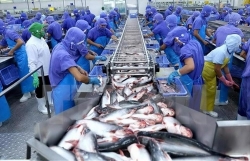VCN – Implementation of the Comprehensive and Progressive Agreement for Trans-Pacific Partnership (CPTPP) has brought impressive export growth to Vietnam. However, large tariff incentives along with conditions of origin and stricter requirements for product materials challenge many Vietnamese businesses much.
 |
| Enterprises need to form actively a chain in terms of raw materials. Photo: H.Diu |
According to the commitment on tariff reduction in the Comprehensive and Progressive Agreement for Trans-Pacific Partnership (CPTPP), the roadmap for tariff reductions is mostly 3-7 years or even up to 10-15 years. In particular, the import tax elimination roadmap can be extended over 20 years. For example, goods exported to Canada can benefit from 0% tax as soon as the agreement takes effect, such as handbags, metal products, plastic and rubber products, crafts, agricultural and aquatic products, footwear, and textiles, which can benefit from incentives in a roadmap from 0 to 3 years.
As a result, in 2021, Vietnam’s export turnover to the CPTPP market reached $45.7 billion, an increase of 18.1% compared to 2020. In the first 10 months of 2022, export turnover to CPTPP countries reached $45 billion, an increase of 22.1% over the same period in 2021. Exports to partner countries in the Americas that had Free Trade Agreements (FTAs) with Vietnam for the first time, such as Canada, Peru, and Mexico, grew strongly.
However, unlike the agreements that Vietnam has signed, the CPTPP has its own chapter on textiles with its own specific regulations in addition to general regulations. In particular, the applicable rule of origin is the “from the yarn onwards” or “3-step” rule, meaning that the entire process of spinning, weaving, dyeing, finishing, and sewing the garment must be implemented within the CPTPP. Compared to previous FTAs, this is a high level of claim rule.
 | Room for exporting sutchi catfish to CPTPP countries VCN – Although sutchi catfish exports to many markets tend to slow down, the market of CPTPP … |
To overcome this situation, some textile and garment enterprises are expected to cooperate with foreign corporations to supply raw materials. In addition, businesses must also comply with the standards for sustainable development in the CPTPP, which requires a “green” production process and raw materials. Experts also recommend that businesses increase the value of export turnover in items with good utilization rates to take advantage of opportunities from the CPTPP.
Huong Diu/ Thu Phuong
